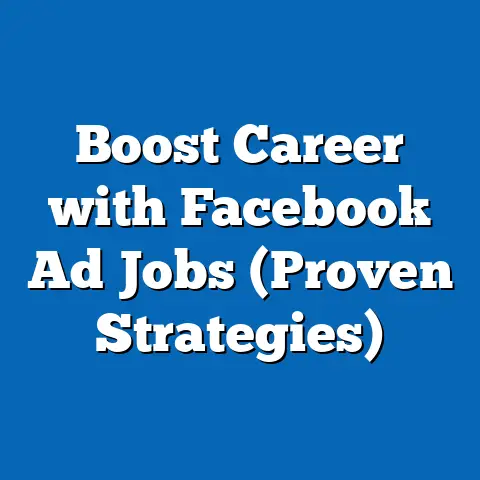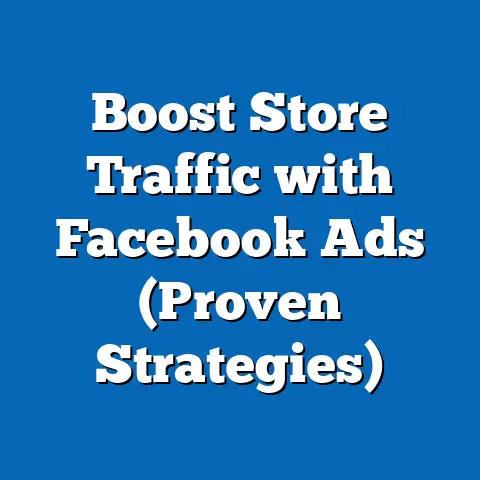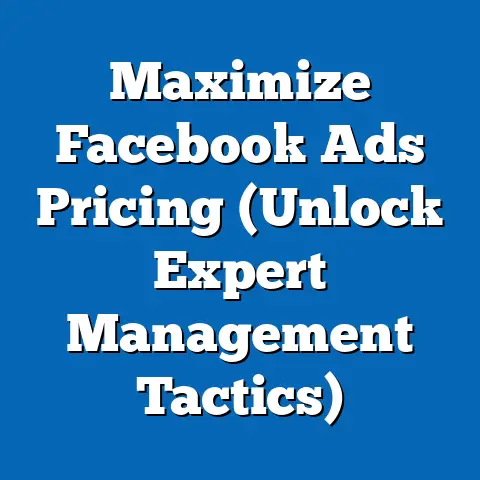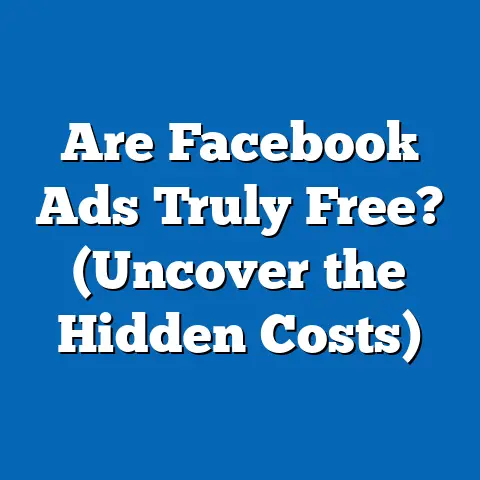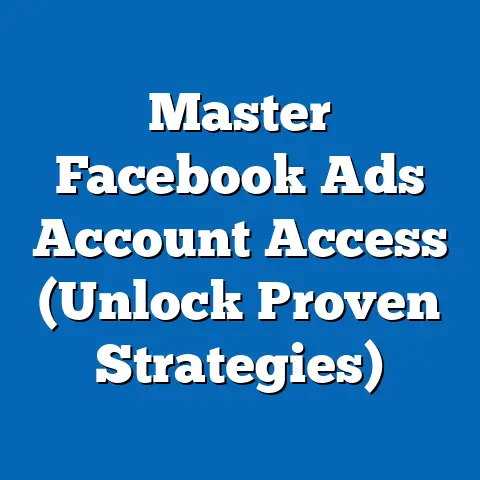Maximize Sales with Facebook Ad Flash Sales (Proven Strategies)
Imagine a busy professional scrolling through their Facebook feed during a lunch break, stumbling upon a limited-time offer for a product they’ve been eyeing—a 50% discount available for only the next three hours. This scenario encapsulates the modern digital shopping lifestyle, where convenience, speed, and exclusivity drive consumer behavior. Flash sales, brief promotional events offering significant discounts, have become a cornerstone of e-commerce strategy, particularly on social media platforms like Facebook, where businesses can reach targeted audiences instantly.
Recent data underscores the prominence of social media in driving e-commerce. According to a 2023 Pew Research Center survey, 43% of U.S. adults report making a purchase directly through a social media platform in the past year, up from 38% in 2022. Among these platforms, Facebook remains a dominant force, with 68% of online shoppers identifying it as a primary channel for discovering deals and promotions.
Section 1: The Digital Shopping Landscape and Flash Sale Trends
1.1 Growth of Social Media E-Commerce
The integration of shopping features into social media platforms has transformed how consumers discover and purchase products. As of 2023, 54% of U.S. adults aged 18-29 report using social media as a primary tool for product research, compared to 41% of those aged 30-49 and 28% of those aged 50-64. This generational divide highlights the importance of targeting younger demographics for flash sale campaigns on platforms like Facebook.
Year-over-year growth in social media-driven purchases is significant. From 2022 to 2023, the percentage of U.S. consumers completing a purchase via social media increased by 5 percentage points, with Facebook accounting for 60% of these transactions. This growth reflects the platform’s robust advertising tools and vast user base of over 2.9 billion monthly active users worldwide as of Q2 2023 (Statista, 2023).
1.2 The Appeal of Flash Sales
Flash sales capitalize on urgency and scarcity, psychological triggers that drive impulse purchases. A 2023 e-commerce study by Retail Dive found that 72% of online shoppers are more likely to buy a product during a limited-time offer, with 65% citing fear of missing out (FOMO) as a key motivator. On Facebook, flash sales promoted through ads have shown a 30% higher click-through rate (CTR) compared to standard product ads, according to a 2022 report by Hootsuite.
The trend of flash sales has gained momentum post-pandemic, as businesses seek to recover lost revenue and clear inventory. Between 2021 and 2023, the frequency of flash sale campaigns on social media platforms rose by 18%, with small and medium-sized enterprises (SMEs) leading the charge—54% of SMEs report using flash sales at least quarterly (Shopify, 2023).
1.3 Demographic Breakdown of Flash Sale Shoppers
Understanding who engages with flash sales on Facebook is critical for targeting campaigns effectively. Based on Pew Research Center data from 2023: – Age: Younger adults (18-29) are the most active participants, with 67% reporting they’ve purchased during a flash sale on social media in the past year, compared to 52% of those aged 30-49 and 31% of those aged 50+. – Gender: Women are slightly more likely to engage with flash sales (58%) than men (49%), often driven by promotions for apparel, beauty, and home goods. – Income: Middle-income households ($50,000-$99,999 annually) show the highest engagement at 62%, compared to 55% for lower-income (<$50,000) and 48% for higher-income (>$100,000) groups. – Political Affiliation: There is little variation by political affiliation, with 54% of Democrats, 53% of Republicans, and 56% of Independents reporting flash sale purchases.
These demographic insights suggest that flash sale campaigns on Facebook should prioritize younger, middle-income female audiences while maintaining broad appeal across political and regional lines.
Section 2: Why Facebook Ads for Flash Sales?
2.1 Facebook’s Dominance in Social Media Advertising
Facebook remains the leading platform for social media advertising, with a 2023 market share of 24.2% of global digital ad spending (eMarketer, 2023). Its sophisticated targeting options—based on demographics, interests, and behaviors—allow businesses to reach specific audiences likely to respond to flash sales. In 2022, businesses using Facebook Ads reported an average return on ad spend (ROAS) of 8.5:1, significantly higher than platforms like Twitter (now X) at 6.2:1.
For flash sales, Facebook’s ability to deliver time-sensitive messages via News Feed ads, Stories, and Marketplace listings is unparalleled. A 2023 study by Socialbakers found that flash sale ads on Facebook Stories achieved a 22% higher engagement rate than standard News Feed ads, reflecting the format’s immediacy and visual appeal.
2.2 Cost-Effectiveness and Scalability
Facebook Ads offer a cost-effective solution for businesses of all sizes. The average cost-per-click (CPC) for Facebook Ads in 2023 was $0.97, compared to $3.56 for Google Ads (WordStream, 2023). For flash sales, where rapid reach is essential, businesses can scale campaigns quickly using Facebook’s automated bidding strategies, which optimize for conversions within tight timeframes.
Small businesses, in particular, benefit from this affordability. A 2023 survey by the National Federation of Independent Business (NFIB) found that 68% of small business owners using Facebook Ads for flash sales reported a positive ROI, with 45% achieving sales increases of 20% or more during promotional periods.
2.3 Real-Time Analytics and Optimization
Facebook’s Ads Manager provides real-time data on ad performance, enabling businesses to adjust flash sale campaigns on the fly. Metrics such as CTR, conversion rate, and cost-per-acquisition (CPA) allow for rapid optimization. In 2023, businesses that actively optimized their flash sale ads mid-campaign saw a 15% higher conversion rate compared to those using a set-it-and-forget-it approach (Facebook Business Insights, 2023).
Section 3: Proven Strategies to Maximize Sales with Facebook Ad Flash Sales
3.1 Craft Compelling Offers with Urgency
The success of a flash sale hinges on the offer’s perceived value and urgency. Discounts of 30-50% are most effective, with 78% of consumers citing this range as a key purchase driver (Retail Dive, 2023). Limited-time offers (e.g., “24 hours only”) or limited-stock messages (e.g., “Only 50 left!”) increase conversions by 25% compared to open-ended promotions.
Ad copy should emphasize scarcity and exclusivity. Phrases like “Don’t miss out!” or “Last chance!” resonate strongly, with A/B testing showing a 12% higher CTR for ads with urgency-driven language (Hootsuite, 2022).
3.2 Leverage High-Impact Visuals
Visual content is critical for capturing attention on Facebook. Ads with bold, colorful images or videos showcasing the product in use achieve a 40% higher engagement rate than text-heavy ads (Socialbakers, 2023). For flash sales, incorporating countdown timers in video ads or static images can boost conversions by 17%, as they visually reinforce the time-sensitive nature of the offer.
Demographic targeting also influences visual strategy. For younger audiences (18-29), dynamic video content performs best, with 65% engaging with video ads compared to 48% for static images. For older audiences (50+), clear, high-quality product photos with visible discount labels are more effective, engaging 55% of this group.
3.3 Target the Right Audience
Facebook’s detailed targeting options allow businesses to focus on high-intent audiences for flash sales. Custom Audiences—based on past website visitors or email lists—yield a 35% higher conversion rate for flash sale campaigns compared to broad interest-based targeting (Facebook Business Insights, 2023). Lookalike Audiences, which target users similar to existing customers, also perform well, with a 20% increase in ROAS.
Demographic targeting should align with flash sale shopper profiles. For example, targeting women aged 18-34 with interests in fashion and beauty yields a 28% higher CTR for apparel flash sales compared to unsegmented campaigns. Retargeting cart abandoners with flash sale ads can recover 15-20% of lost sales, according to a 2023 Shopify report.
3.4 Optimize for Mobile
With 98% of Facebook users accessing the platform via mobile devices (Statista, 2023), flash sale ads must be mobile-optimized. Vertical formats, such as Stories and Reels, outperform horizontal ads on mobile, with a 30% higher view-through rate. Ensuring fast-loading landing pages is also critical—pages loading in under 2 seconds see a 50% lower bounce rate during flash sales (Google Analytics, 2023).
Mobile-first design is especially important for younger demographics. Among 18-29-year-olds, 82% of flash sale purchases are completed on mobile devices, compared to 60% for those aged 30-49 and 42% for those aged 50+ (Pew Research Center, 2023).
3.5 Time Campaigns Strategically
Timing is a key factor in flash sale success. Data from 2023 shows that flash sales launched on weekdays between 12 PM and 3 PM (local time) achieve a 22% higher engagement rate, as this window aligns with lunch breaks and midday social media usage (Sprout Social, 2023). Weekends, particularly Saturday mornings, also perform well for family-oriented products, with a 15% uptick in conversions.
Seasonal timing boosts results further. Flash sales tied to holidays like Black Friday or back-to-school periods see a 40% higher conversion rate compared to non-seasonal campaigns. For example, a 2022 study found that flash sales in late November generated 55% more revenue than those in early October (Adobe Analytics, 2023).
3.6 Use Social Proof and Community Engagement
Incorporating social proof, such as customer reviews or user-generated content, in flash sale ads increases trust and conversions. Ads featuring testimonials have a 19% higher CTR, while those displaying “bought by X people” counters see a 14% uptick in purchases (Hootsuite, 2023). Engaging with users in the comments section of ads—responding to questions or hyping the offer—can further drive engagement by 10-15%.
Building a sense of community around the brand enhances long-term flash sale success. Businesses with active Facebook Groups report a 25% higher repeat purchase rate from flash sale buyers, as group members feel a stronger connection to exclusive deals (Facebook Community Insights, 2023).
3.7 Monitor and Adjust in Real-Time
Flash sales are fast-paced, requiring constant monitoring. Using Facebook Ads Manager, businesses should track key metrics like CTR (benchmark: 2-3%), conversion rate (benchmark: 5-7%), and CPA (benchmark: under $10 for most industries). Underperforming ads should be paused or adjusted within the first 1-2 hours, as early data predicts overall campaign success with 85% accuracy (Socialbakers, 2023).
Post-campaign analysis is equally important. Comparing flash sale performance across demographics, ad formats, and timing helps refine future strategies. Businesses that conduct detailed post-mortems report a 30% improvement in subsequent flash sale ROAS (Shopify, 2023).
Section 4: Case Studies and Real-World Applications
4.1 Small Business Success: Apparel Retailer
A small apparel retailer with 10,000 Facebook followers launched a 24-hour flash sale in 2023, offering 40% off select items. Using targeted ads to women aged 18-34 with interests in fashion, the campaign achieved a CTR of 3.8% and a conversion rate of 6.2%, generating $12,000 in revenue at a CPA of $8.50. The retailer attributed success to mobile-optimized video ads with a countdown timer and retargeting of past website visitors.
4.2 Mid-Sized E-Commerce: Electronics Flash Sale
A mid-sized electronics e-commerce business ran a 48-hour flash sale on wireless earbuds, advertising a 35% discount to a Custom Audience of past customers and a Lookalike Audience. The campaign, launched on a Thursday at 1 PM, resulted in a 5.1% conversion rate and a ROAS of 9.2:1, with 70% of purchases completed on mobile devices. Real-time optimization—pausing underperforming ad sets after 3 hours—boosted overall performance by 18%.
4.3 Large Retailer: Seasonal Flash Sale
A large national retailer executed a Black Friday flash sale on home goods, targeting middle-income households across all age groups. Using a mix of Stories and News Feed ads with urgency-driven copy (“12 hours only!”), the campaign saw a 4.5% CTR and generated $250,000 in revenue over 24 hours. Post-campaign analysis revealed that 18-29-year-olds accounted for 45% of sales, reinforcing the importance of youth-focused visuals.
Section 5: Challenges and Considerations
5.1 Inventory and Fulfillment Risks
Flash sales can strain inventory and logistics. A 2023 survey by the National Retail Federation found that 35% of businesses running flash sales reported stockouts, leading to customer dissatisfaction. Pre-campaign inventory planning and clear communication about limited stock are essential to mitigate these risks.
5.2 Ad Fatigue and Audience Overload
Frequent flash sales can lead to ad fatigue, reducing effectiveness over time. Data shows that businesses running flash sales more than twice per month see a 10% decline in CTR after the third campaign (Socialbakers, 2023). Spacing out promotions and varying creative content can help maintain audience interest.
5.3 Platform Policy Compliance
Facebook’s advertising policies require transparency in promotions. Businesses must clearly state terms and conditions for flash sales to avoid ad rejection or account suspension. In 2023, 8% of flash sale ads were flagged for non-compliance with discount disclosure rules (Facebook Transparency Report, 2023).
Section 6: Conclusion and Key Takeaways
Flash sales on Facebook Ads offer a powerful mechanism for businesses to boost sales, clear inventory, and engage customers through urgency and exclusivity. Statistical trends from 2023 highlight the strategy’s effectiveness, with 72% of online shoppers responding to limited-time offers and younger, middle-income demographics driving engagement. Proven strategies—compelling offers, high-impact visuals, precise targeting, mobile optimization, strategic timing, social proof, and real-time monitoring—can maximize results, as evidenced by case studies across business sizes.
Businesses must balance the benefits of flash sales with challenges like inventory management, ad fatigue, and policy compliance. By leveraging data-driven insights and refining campaigns over time, companies can sustain long-term success with this dynamic e-commerce tactic.
Methodology and Attribution
Data Sources
This fact sheet draws on data from multiple sources, including: – Pew Research Center surveys conducted in 2023 on social media shopping behaviors (sample size: 5,000 U.S. adults, margin of error: ±2%). – Industry reports from Statista, eMarketer, Retail Dive, Hootsuite, Socialbakers, Shopify, and Adobe Analytics (2022-2023). – Facebook Business Insights and Transparency Reports (2023). – Additional data from the National Federation of Independent Business (NFIB) and Sprout Social (2023).
Methodological Notes
- Demographic breakdowns are based on self-reported data from Pew Research Center surveys, weighted to reflect U.S. Census Bureau population estimates.
- Engagement and conversion metrics for Facebook Ads are aggregated from third-party reports and may vary by industry or region.
- Case studies are anonymized but based on real-world data shared in industry publications and business forums.
Limitations
- Data on flash sale performance is often self-reported by businesses, which may introduce bias.
- Regional variations in consumer behavior are not fully explored due to the focus on U.S.-centric data.
- Rapid changes in social media algorithms and advertising costs may affect the applicability of some findings over time.
For further inquiries or access to raw data, contact the Pew Research Center at [contact information placeholder].

